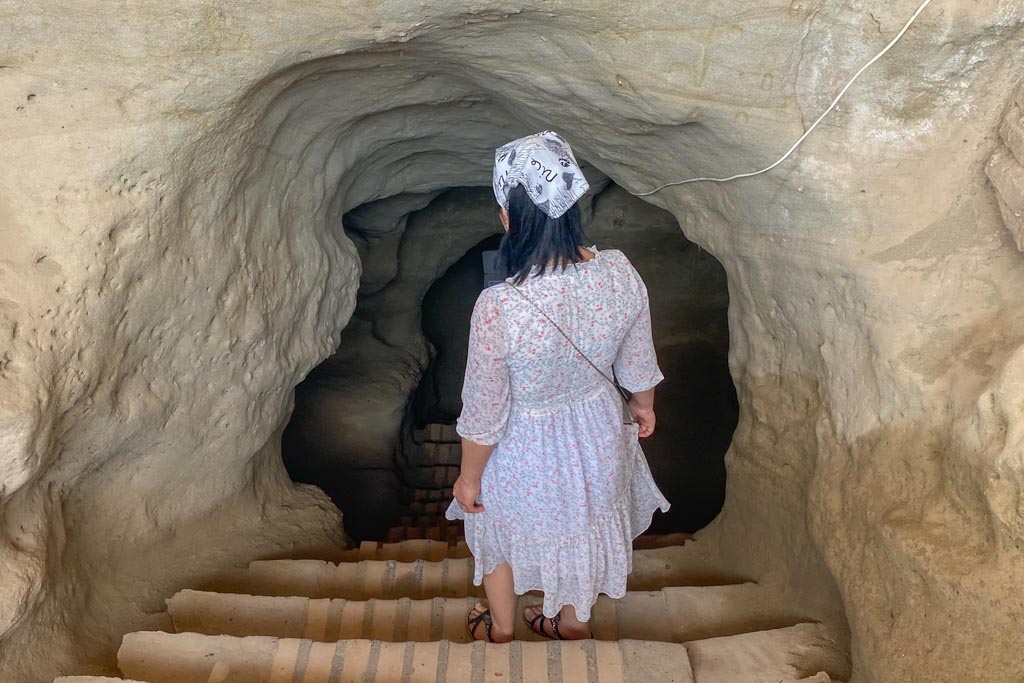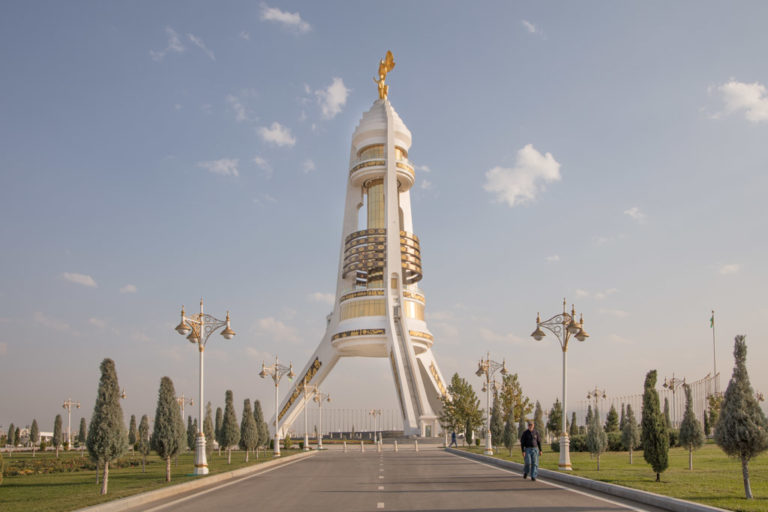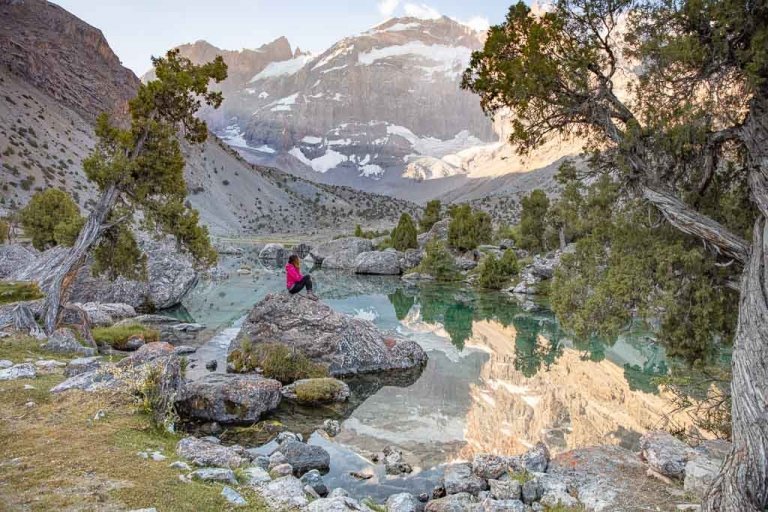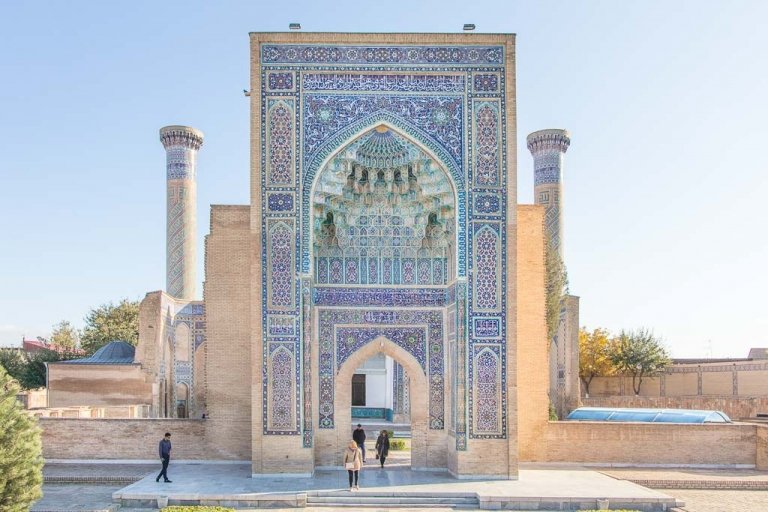
Exploring the Frontier Town of Termez, Uzbekistan
Updated June 2023, Exploring the Frontier Town of Termez, Uzbekistan was originally published in September 2021
With a history stretching back over 2,500 years visiting Termez is a must for any history lover’s Uzbekistan itinerary. The town now sits along the border between Uzbekistan and Afghanistan but has historically sat at the crux of empires.
From fascinating Buddhist sites, one of the best museums in all of Uzbekistan, and to decadent mausoleums, Termez offers plenty of things to do for any visitor making the journey to the Uzbek south.
I found myself in Termez for a couple of days, before crossing the Friendship Bridge over the Amu Darya at the Hairatan Border Crossing to Afghanistan. Though the journey to Termez is a bit long from other cities in Uzbekistan, I would still recommend putting Termez on your itinerary if you have time (even if you weren’t planning to go to Afghanistan afterward as I did).
Start planning your Uzbek adventure with the Uzbekistan travel guide
Pick up a copy of Bradt’s Uzbekistan Guidebook too

The best way to visit all the sites in and around Termez
While it’s possible to visit a number of Termez’s highlights on the cheap by using marshrutkas and/or shared taxis, you will have to expend a lot of time in transit, haggling with drivers, and walking in the blistering sun to some of the sites that aren’t located right on the main roads and highways in and around the city. For those reasons, I recommend arranging a car to take you out on a half or full-day trip to hit the sites around Termez.
I went on a several-hour-long trip with a driver I had arranged through the Asson Hotel where I stayed during my visit to Termez. You should pay about $20 USD to visit the Kirkkiz Fortress, Sultan Saodat and Kokildor Khanaka, Fayez Tepe and Kara Tepe, Zurmala Tower, and Old Termez/Al Hakim al Termezi. An additional $10 will also get you out to Kampyr Tepe.
Looking for ideas? Check out the two week Uzbekistan itinerary
Things to do in Termez (and around)

Archeological Museum of Termez
Your first stop after arriving in Termez should be to pay a visit to the Archeological Museum of Termez to familiarize yourself with the extensive history of the Termez and Surkhondaryo Region.
A true highlight of the museum is its extensive collection of 3rd-4th century Buddhist artifacts, in addition to the displays of Bronze age ceramics, Alexander the Great and Greco-Bactrian Exhibit, gorgeous paintings, and more.
Entrance: 20,000 UZS, 5,000 UZS additional for cameras

Old Termez & Al Hakim al Termezi Mausoleum
Northwest of modern Termez by 6 kilometers sits the Mausoleum of Al Hakim al Termezi and the old city of Termez. To access the Mausoleum of Al Hakim al Termezi and Old Termez, you can take marshrutka #15, 12, or 305 from Yubileynyi Bazaar if you aren’t paying a visit to Termez’s historic sites as a day trip with a hired driver.
From the M39, you’ll turn west, driving through a gate- a Disneyified version of historic walls, continuing along a tree-lined road to a car park that goes to the Mausoleum of Al Hakim al Termezi, with Old Termez being only a short walk away.


Mausoleum of Al Hakim al Termezi
Al Hakim was a famous Sufi saint and writer who died in Termez in 859 AD. Some of the buildings found in the complex date back to the 10th century, however much of the construction happened under the reign of Shah Rukh in the 15th century.
The mausoleum is quite impressive with beautiful white marble walls featuring blue and gold details. This is the holiest site in Termez, so make sure to dress respectfully (knees and shoulder covered at minimum) as many visitors are there to pay religious respects.
Outside, make sure to follow the signs to the Chillkhona. It’s a cave system where locals and pilgrims go to pray, plus its about 20 degrees cooler down inside which will be a welcomed break from the heat.
The grounds feature a beautiful garden with blooming trees as well as the Archeological Museum of Termez Ota which is an offshoot of the larger archeological museum in modern Termez, featuring artifacts that have been excavated at the site of nearby Old Termez. The Archeological Museum of Termez Ota does charge a 15,000 UZS fee for entry.

Old Termez
After the originally inhabited Kampyr Tepe was abandoned, the site of Old Termez was developed. For over a millennia the town bustled, boasting homes, caravanserais, bazaars, and even an impressive irrigation canal system. Not a lot remains of Old Termez following the Mongol destruction of the city, but it’s worth a visit to get a sense of the history of Termez.

Sultan Saodat Complex
The Sultan Saodat Complex is a sight to behold, serving as a necropolis for the Termez Sayyids, descendants of Ali. The complex does share some architectural similarities with the more famous Shah i Zinda in Samarkand, though it is simpler in decorations as this was a site dedicated to holy men, rather than royalty. Sultan Saodat includes mosques, mausoleums, and a khanaka.
Construction of the Sultan Saodat Complex took place between the 11th and 17th centuries. Despite being built under an Islamic period, several motifs seen at the complex feature symbols from Buddhism and Zoroastrianism.
In 2002 the Sultan Saodat Complex underwent extensive restoration to its unique brickworks and Timurid era architecture.
Sultan Saodat (along with Kokildor Khanaka) is reachable by marshrutka #265 + a 15 minute walk.

Kokildor Khanaka
Just a short walk west of the Sultan Saodat Complex is the Kokildor Khanaka, which served as a meditation and resting place for Sufis and holy men.
The structure, which dates back to the 16th century and built under the reign of Abdullah Khan II of Bukhara, features several similarities to mosques, madrasas, and khanakas found in Afghanistan.

Kirkkiz Fortress
Kirkkiz Fortress sits just outside Termez near the airport that dates back to the 11th century, however, researchers have never agreed on what the purpose of the structure was for. Two of the most viable theories are that it was a large caravanserai or a Samanid era summer palace.
The name Kirkkiz means 40 Girls Fortress, but the lore behind the name has been unfortunately lost. One of the most popular legends is that the 40 girls, led by Princess Gulam fought off nomads following the deaths of their husbands.
Wandering around Kirkkiz was one of my favorite stops along my day trip of the Termez historic sites as the fortress is quite substantial. With an estimated 50 rooms spread out over two stories, you could get a real sense of the grandeur of the site.
Get way off the beaten path and check out the lost Khorezm Fortresses and the mysterious Karakalpak Republic
Zurmala Tower
The Zurmala Tower is the only remaining part of an impressive Buddhist stupa that is among the oldest structures in Uzbekistan still standing. The tower is located about 2 kilometers from the northern end of the city and the closest you can get to it with a car is about 200 meters away, so if you want to see it up close you’ll need to walk a little way. Make sure and wear sandals or some kind of shoe that you don’t mind if they get wet.

Fayez Tepe
One of Termez’s most interesting sites is the ancient Buddhist monastery of Fayez Tepe.
The monastery and stupa of the Fayez Tepe complex date back to the 1st century BC when this region was under the control of the Kushan Empire, though much of the site’s development happened in the 3rd century AD.
After the site was abandoned, it mostly sat left in ruin until it was discovered by a shepherd in the area in the late 1960s. Shortly after its discovery, Soviet archeologists began excavating the site.

As you approach the monastery, you will find a signboard with information about Fayez Tepe and nearby Kara Tepe. A man living near here may see you and give you a tour. He also has the keys to open up the large domed stupa that was built to protect the original stupa inside.
The remainder of the grounds is worth exploring too to see what would have been dormitories, hammam, kitchens, and so on.
Many impressive artifacts were unearthed here at Fayez Tepe, though almost all are on display at the Termez Archeological Museum.
Exploring southern Uzbekistan? Don’t miss nearby Qarshi

Kara Tepe
Another of my favorite things to do in Termez visiting the site of Kara Tepe. Kara Tepe dates back to the early 2nd century where it served as a Buddhist temple complex and reached its zenith in the 3rd and 4th centuries. It would go on to be largely abandoned by the late 4th century, though a handful of monks allegedly stuck around until the 6th century.
Due to its proximity to the Afghan border, Kara Tepe is sometimes off-limits to visitors or requires a permit that must be arranged in advance at times. With that said, there were no restrictions when I visited in May 2021, so I was allowed to wander the site of Kara Tepe freely and did not have to acquire a permit. You may want to enquire with the Termez Archeological Museum before you leave town to find out the most current situation.
Kick off your trip to Uzbekistan in the capital with the Tashkent Travel Guide

Kampyr Tepe
Kampyr Tepe was #1 of all the things to do in Termez, for me anyway. It’s a bit of a distance at 30 kilometers from Termez, but in my opinion, it was well worth the journey.
Kampyr Tepe was a once booming Macedonian city of Bactria that sat right on the banks of the Amu Darya founded by Alexander the Great in the 4th century BC, hence the nickname of Alexandria on the Oxus. The city flourished for about 400 years before the Amu Darya’s course changed and flooded Kampyr Tepe, forcing its residents to move elsewhere.

The citadel sits on a hill giving sweeping views of the Amu Darya and across the border into Afghanistan. Featuring over 100 rooms, countless ceramic pieces, sculptures, and even Bactrian manuscripts have been recovered here.
Buddhist stupas, Zoroastrian temples, and Hellenistic monasteries have all been unearthed at Kampyr Tepe leading researchers to believe that the three religions coexisted together here peacefully under the Kushan Empire.
The day I visited there was a crew of archeologists and researchers excavating a portion of Kampyr Tepe that excitedly showed me their work and invited me for chai.

Jarkurgan Minaret
Built by architect Ali ibn Muhammad Serakhsi in the 12th century, the Jarkurgan Minaret is among the oldest in Central Asia. The minaret features beautiful herringbone brickwork. The Jarkurgan Minaret is situated about 38 kilometers from Termez en route toward Denau (unfortunately I ran out of time and didn’t get to visit myself on this trip!).
Don’t miss the Silk Road cities of Samarkand, Bukhara, and Khiva

Hairatan Friendship Bridge
Ironically named, the Friendship Bridge serves as the Hairatan Border Crossing between Uzbekistan and Afghanistan. The bridge was constructed in 1982 following the 1979 Soviet Invasion of Afghanistan as a means to get supplies to their troops in northern Afghanistan.

Best Restaurants in Termez
Azizbek Restaurant: My favorite of the handful of eateries I tried out on my stay in Termez. The shashlik was excellent (farsh is my favorite!), the bread soft, and the Baltica perfectly chilled, plus the outdoor seating is hard to beat. You may struggle if you don’t know any Uzbek or Russian, but if that’s the case it’s still worth the challenge.
Fast food shops on Hakim at Termezi Ko’chasi: Several small western-style fast food shops slinging up pizza, burgers, and sandwiches, as well as the ubiquitous chaikhana line Hakim at Termezi Street as you walk southwest from the Hotel Asson toward the Yubileynyi Bazaar- all of which offer street-side seating.

Where to Stay in Termez
Budget: The Surkhon Hotel offers up basic rooms for a steal. It came highly recommended by other backpackers.
Midrange: The Asson Hotel is located conveniently next to the Termez Archeological Museum. Rooms are simple and beds are comfortable (not the usual rock-hard mattresses you find everywhere in Central Asia!). They have a pool, but it was, unfortunately, being renovated at the time of my visit.


Getting to and from Termez
Termez is a long way from just about everywhere in Uzbekistan, so most visitors tended to be those headed for the Afghan border in the past. The city does have a train station, bus station, and airport so you do have multiple options for transport.
By road: The Termez Main Bus Station is west of the city where you can find marshrutkas and shared taxis plying the routes to Samarkand, Shahrisabz, Qarshi, Denau, Tashkent, and other destinations. To get to the city center from the bus station grab marshrutka #2, 7, or 8.
By train: The Termez Train Station is easily reached as it’s located on the northern end of town (take marshrutka #4 from Yubileynyi Bazaar). It’s possible to get to Qarshi, Denau, and Tashkent (among other destinations) from Termez. You can book your Uzbek Railways ticket online, or download the app and do it from your phone (App Store | Google Play).
By plane: Several flights per week connect Termez and Tashkent on Uzbekistan Airways. You can also shop for the best deals on Skyscanner. Marshrutka #11 runs the route between the airport and the Yubileynyi Bazaar, though getting a taxi is easy enough.

Crossing the Hairatan Border to Afghanistan
In May 2021, I returned to Afghanistan and crossed the border at Hairatan to get to Mazar e Sharif. At the time the border crossing procedures were a breeze and took less than 30 minutes on both sides.
Unfortunately, due to the recent Taliban sweep of Afghanistan and the crisis the country is embroiled in, visiting Afghanistan is not recommended right now. But if you want to read about the border crossing and its proceedings, check out my guide to the Hairatan Border Crossing.
Have any questions about any of the things to do in Termez?
Ask in the comments section below.
Need Travel Insurance for Uzbekistan?
Start shopping plans over at battleface, my go-to travel insurance choice, or over at World Nomads.


























